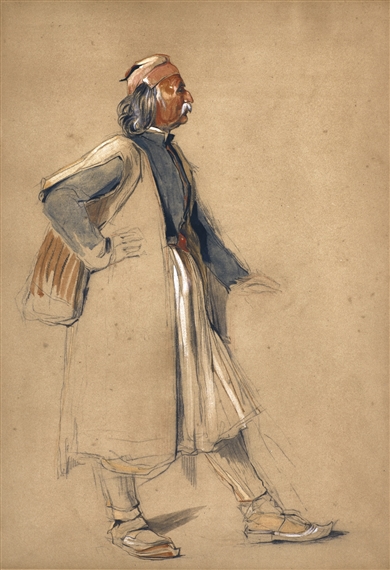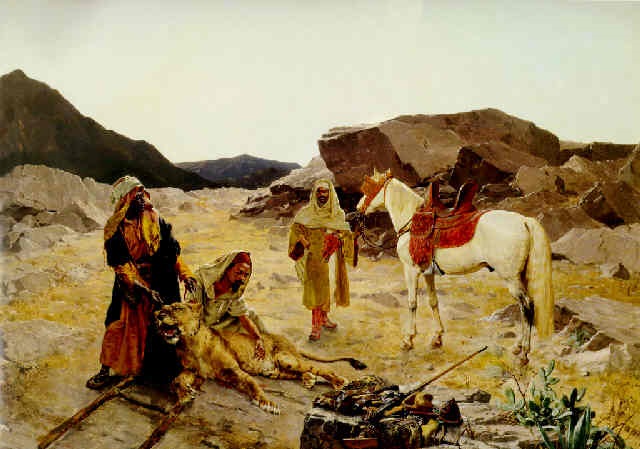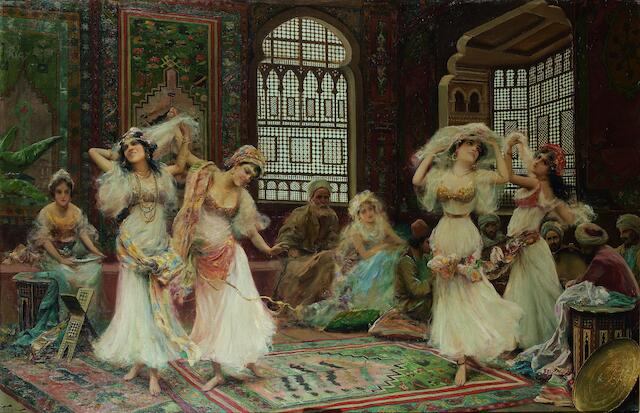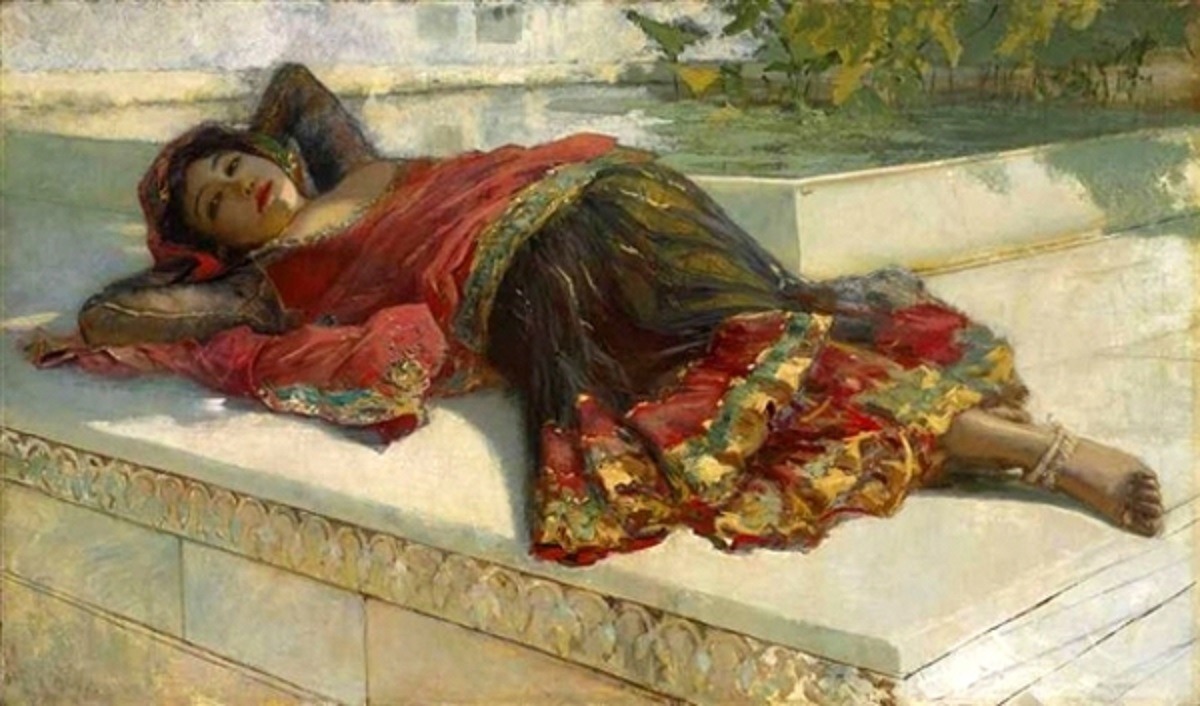ALBANIAN GUARDS IN BURSA, TURKEY
John Frederick Lewis
Watercolour over pencil, heightened with bodycolour, black chalk
19.69 X 14.57 in (50 X 37 cm)
Private collection
Sold for 118,750 GBP in April 2016
After several months in Constantinople, Lewis travelled to nearby Bursa , where he made studies of the local people.
Albanians, whose own country was poor and mountainous, were often employed as guards or soldiers to keep order in the provinces or towns of the Ottoman Empire. Renowned for their fighting prowess, their colourful costume was admired by many Western visitors. As often, with Lewis’s Eastern drawings, he takes a popular subject and, through his intense scrutiny of it, creates a powerful image with far more substance than those of his predecessors.
Exactly what these individuals have been guarding or where they are seated is not clear, but their bare feet seem to imply that they are off duty, possibly in a café. Lewis has deliberately left out their surroundings, so as to focus more intently on their apparel and impressive array of weaponry. The older, bearded man wears a white cotton kilt (fustanella) with a warp-tied dyed silk jacket, and holds the hilt of his sabre (kılıç); the younger man, smoking a çubuk (long-stemmed tobacco pipe), is wearing breeches (dizlik), and has a different type of sword, a yatağan, tucked into the sash around his waist.
More on this painting
John Frederick Lewis RA (London 14 July 1804 – 15 August 1876) was an Orientalist English painter. He specialized in Oriental and Mediterranean scenes in exquisitely detailed watercolour or oils. Lewis lived for several years in a traditional mansion in Cairo, and after his return to England in 1851 he specialized in highly detailed works showing both realistic genre scenes of Middle Eastern life and more idealized scenes in upper class Egyptian interiors with no traces of Western cultural influence yet apparent.
His very careful and loving representation of Islamic architecture, furnishings, screens, and costumes set new standards of realism, which influenced other artists, including the leading French Orientalist painter Jean-Léon Gérôme in his later works. Unlike many other Orientalist painters who took a salacious interest in the women of the Middle East, he "never painted a nude", and his wife modelled for several of his harem scenes. These, with the rare examples by the classicist painter Lord Leighton, imagine "the harem as a place of almost English domesticity, ... [where]... women's fully clothed respectability suggests a moral healthiness to go with their natural good looks" More on John Frederick Lewis

SEATED ARAB MERCHANT AT SUEZ
John Frederick Lewis
Watercolour over black chalk, heightened with bodycolour and gum arabic
13.78 X 17.32 in (35 X 44 cm)
Private collection
Sold for 173,000 GBP in April 2016
During his nearly ten year sojourn in Cairo in the 1840s, Lewis visited Sinai several times, passing through Suez on his route. The port on the Gulf of Suez, at the northern end of the Red Sea, had not yet assumed the significance it would attain after the opening of the Suez Canal in 1869, but it was nevertheless an important centre of trade between the Mediterranean and the Indian Ocean. Traders from the towns of Yemen and Arabia would congregate there and this individual is likely to be a wealthy merchant.
He is seated, bare foot, and wears a rich red gibbeh (or jubbah: outer robe), with a red and yellow striped shawl wrapped loosely around his head and shoulders. He holds the end of the long sheesha (hookah) pipe to his mouth, smoking contemplatively. More on this painting
AN OLD SULIOTE
John Frederick Lewis
Watercolour, black chalk and bodycolour on buff-coloured paper
14.96 X 10.83 in (38 X 27.5 cm)
Private collection
Estimate for 15,000 - 25,000 GBP in April 2016
On his journey through Greece and Albania in late summer 1840, Lewis made several sketches of men wearing traditional costume. In this example, attention is focused on the strong features of the venerable old man, with his long greying hair, white moustache and large hook nose. He wears the customary pleated kilt (fustanella), stiffened with mutton fat, a three-quarter length sleeveless coat, and a distinctive red cap.
Here the man seems to be standing on the balcony of a large house and rests his hand on its wooden balustrade; beyond, lightly but deftly drawn, is another large wooden building and a snow-capped mountain. These details suggest that the location may be Ioannina, a substantial town and the centre of the mountainous region of Epirus, then still in Albania and under Ottoman rule. More on this painting
INTERIOR OF SULTANAHMET CAMII (THE BLUE MOSQUE), CONSTANTINOPLE
John Frederick Lewis
Watercolour over pencil
21.26 X 14.76 in (54 X 37.5 cm)
Private collection
Sold for 42,500 GBP in April 2016
On 22 November 1840, Lewis joined the party of Lady Londonderry to visit Haghia Sophia, Topkapı Sarayı and some of the great imperial mosques of Constantinople. Westerners were not allowed to enter these mosques without a firman (an official permit), which was granted only to a few visitors, usually those with status, such as Frances Anne, wife of Charles Vane, 3rd Marquess of Londonderry, who was accompanying her husband on a journey through the courts of Europe.
Lewis has taken a view from the north-west corner of the mosque, looking towards the doorway on the south-west; left of centre is one of the four colossal, free-standing, fluted columns that support the great dome and to right the upper mahfil, or balcony, supported by black and white arches. By choosing not to highlight the blue Iznik tiles in which the entire lower part of the walls is clad, and which give the mosque its popular name, Lewis achieves a much greater sense of the vast interior space. Small figures seated near the western doorway, emphasise both the mosque’s immense size and its function as a place of worship and contemplation. More on this painting
OUTDOOR GOSSIP, CAIRO, c. 1873
John Frederick Lewis
Oil on board
12.01 X 7.87 in (30.5 X 20 cm)
Private collection
Estimate for 300,000 - 500,000 GBP in April 2016
Nearly two-thirds of the male picture is occupied by an interior space, bathed not in light but in shadow, in which stands the dominant figure clothed in rich red and smoking his chibouk (long fruit-wood pipe); although the outside world is glimpsed top left, the figure standing at the threshold between out and in, faces inward, not out. In the depths of the dimly-lit interior is a grilled window (top right) though since it too is situated in a dark interior, it is difficult to discern just who or what is behind it. More on this painting
THE DOUBTFUL COIN, c. 1869
After John Frederick Lewis
Watercolour and gouache
8.07 X 9.37 in (20.5 X 23.8 cm)
Birmingham Museums Trust
THE WADI AT BOU SAADA, c1893
Eugène-Alexis Girardet
Oil on canvas
26.77 X 42.91 in (68 X 109 cm)
Private collection
Sold for 380,000EUR in June 2008
Girardet appears here as one of the greatest painters in the history of orientalist painting. His fine and elegant brushwork is unrivaled in the representation of scenes and landscapes of southern Algeria, all of scorching heat.
Here, overcome with heat, the little characters walk under a dazzling solar glow. This shimmers in the water of the wadi and makes the blonde, orange or saffron yellow minerality of the rocks and walls shine, which contrast with the greens of the plants. Girardet has an extraordinary talent for the naturalistic depiction of the South Algerian people and landscapes.
More on this painting
Eugène Alexis Girardet (31 May 1853, Paris - 5 May 1907, Paris) was a French Orientalist painter. He came from a Swiss Huguenot family. His father was the engraver Paul Girardet (1821-1893). He studied at the École des Beaux-arts and in the studios of Jean-Léon Gérôme, who encouraged him to visit North Africa in 1874.
In all, he made eight trips to Algeria after 1879, especially to the south, around the oases of Biskra, El Kantara and Bou Saâda, where he worked with Étienne Dinet. In 1898, he visited Egypt and Palestine, producing many works depicting the lives of desert nomads.
He exhibited regularly at the Salon and with the Société des Peintres Orientalistes Français (of which he was one of the founding members), with major shows at the Exposition Universelle (1900) and the Exposition Coloniale de Marseille of 1906.
In addition to several museums in France, his works may also be seen at the Dahesh Museum of Art and the National Museum of Fine Arts of Algiers. More on Eugène Alexis Girardet
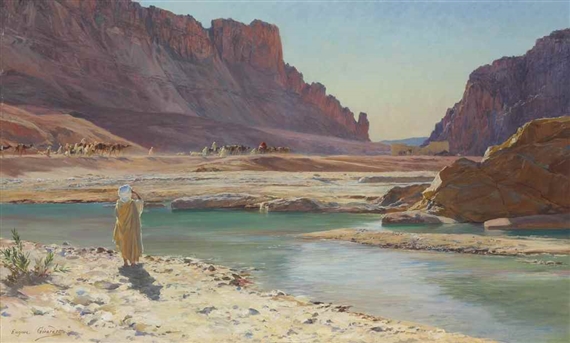
THE PASSING CARAVAN
By Eugène-Alexis Girardet
Oil on board
27 X 43.5 in (68.58 X 110.49
Private collection
Sold for GBP 149,000 in Dec 2016
Probably set in southern Algeria, A Passing Caravan captures the effect of the bright desert light on rock, sand, water and the human figure. It is a tour-de-force in the use of broad, yet controlled brushstrokes, a tightly controlled palette of blues, violets, greys and brown, and strong compositional elements. These bring the viewer slowly through the imposing and strikingly beautiful landscape united by the clear, hot light of the Algerian desert. The figure in the foreground is backlit by the sun. His hand is lifted to shade his eyes from the harsh effects of the sunlight, offering him a glimpse of the passing caravan in the middle ground which is dwarfed by the jagged peaks of the purple mountains that frame the composition. The caravan slowly lumbers away from the solitary figure on the shore of the river, slowly engulfed by the darkest shadows of the imposing rock formations. More on this painting
Les Enfants Du Cordonnier/ The Cobbler's Children, c. 1887
By Eugène-Alexis Girardet
Oil on board
13.19 X 15.16 in (33.5 X 38.5 cm)
Private collection
Estimate for MAD 80,000 - MAD 100,000 in December 2022
Eugène Alexis Girardet
Le marchand de fruits, 1874
Oil on canvas
55 x 38 cm. (21.7 x 15 in.)
Private collection
Estimated for €65,000 EUR - €70,000 EUR in December 2011
MARKETPLACE AT THE ENTRANCE TO A BAZAAR, CONSTANTINOPLE
By Alberto Pasini
Oil on linen
15.25 X 18.25 in (38.74 X 46.36 cm)
Private collection
Sold for £150,250 in Oct 2021
Pasini was struck by the delicacy of the light in the East. His treatment of the play between shadow and the sun and his almost photographic representation of architecture and figures are a world apart from the imaginary exoticism of earlier Orientalist paintings.
Alberto Pasini (Busseto, 3 September 1826 – Cavoretto, 15 December 1899) was an Italian painter. He is best known for depicting Orientalist subjects in a late-Romantic style. His father was a commissioner for his district, a post analogous to a sub-prefect. But orphaned of father in 1828, his mother moved to Parma, where enrolled at the age of 17 years, in the Academy of Fine Art of Parma, studying landscape painting and drawing. In Parma, he was helped early on by Alberto's uncle, the painter and manuscript illuminator, Antonio Pasini, who painted for the local nobility and collaborated with the publishing house established by Giovanni Battista Bodoni. By 1852, he exhibited a series of thirty designs, made into lithographs, depicting various castles around Piacenza, Lunigiana and Parma. He was noticed by the artist Paolo Toschi, who encouraged Pasini to travel to Paris, where Pasini first joined the workshop of Charles and Eugène Ciceri, of the so-called School of Barbizon.
In 1853 his lithograph of The Evening gained him admittance to the Paris Salon, and to the workshop of the famous Théodore Chassériau. The eruption of the Crimean War offered a new opportunity, when in February 1855, this latter painter recommended Pasini to replace him on the entourage of the French plenipotentiary minister Nicolas Prosper Bourée to Persia. Pasini accompanied him, returning through the north of Persia and Armenia before reaching the port of Trebizond. In subsequent trips, he visited Egypt, the Red Sea, Arabia, Istanbul, and Persia. Pasini parlayed his exposures during this trip into numerous highly detailed paintings of orientalist subjects. He left again for Istanbul in October 1867, summoned by the French Ambassador Bourée. He returned to Turkey in 1876 to execute the four paintings commissioned by Sultan Abdul Aziz. He was about to return to Istanbul the next year, when his patron, the Sultan, died.
In 1865, he spent some time in Cannes, painted landscapes of the Riviera. During the Franco-Prussian War of 1870, he returned to Italy, settling in Cavoretto, on the hills around Turin. He continued to travel, closer to his home, with trips to Venice and two sojourns in Spain in 1879 and 1883. More on Alberto Pasini

Alberto Pasini, (1826/1899)
Market Day in Constantinople, c. 1877
Berkshire Museum, Pittsfield, MA, United States
Berkshire Museum
Following his return from Constantinople, Pasini's work in the 1870s is filled with references to the Ottoman world; the present lot incorporates drawings made of the Mısır Çarşısı -also called the Egyptian or Spice Bazaar- in Constantinople. Teeming with life, this work brilliantly demonstrates Pasini's naturalistic style and his subtle use of colour. More on this painting
Alberto Pasini, (1826 - 1899)
Horse market, Syria
Oil on canvas
Height: 840 mm (33.07 in). Width: 1,030 mm (40.55 in).
Art Gallery of New South Wales
Alberto Pasini, (1826 - 1899)
Arab Caravan, c. before 1899
Oil on canvas
Private collection
Alberto Pasini, 1826 - 1899
BY THE FOUNTAIN, CONSTANTINOPLE, c. 1882
Oil on canvas
46 by 38.5cm., 18 by 15¼in.
Delacroix Eugene
Arab Riders on Scouting Mission
Oil Painting on Canvas
36” inches wide by 18” inches high
Hermitage Museum
Ferdinand Victor Eugène Delacroix (French: 6 April 1798 – 13 August 1863) was a French Romantic artist regarded from the outset of his career as the leader of the French Romantic school.
As a painter and muralist, Delacroix's use of expressive brushstrokes and his study of the optical effects of colour profoundly shaped the work of the Impressionists, while his passion for the exotic inspired the artists of the Symbolist movement. A fine lithographer, Delacroix illustrated various works of William Shakespeare, the Scottish writer Walter Scott and the German writer Johann Wolfgang von Goethe.
In contrast to the Neoclassical perfectionism of his chief rival Ingres, Delacroix took for his inspiration the art of Rubens and painters of the Venetian Renaissance, with an attendant emphasis on colour and movement rather than clarity of outline and carefully modelled form. Dramatic and romantic content characterized the central themes of his maturity, and led him not to the classical models of Greek and Roman art, but to travel in North Africa, in search of the exotic. Friend and spiritual heir to Théodore Géricault, Delacroix was also inspired by Lord Byron, with whom he shared a strong identification with the "forces of the sublime", of nature in often violent action.
However, Delacroix was given to neither sentimentality nor bombast, and his Romanticism was that of an individualist. In the words of Baudelaire, "Delacroix was passionately in love with passion, but coldly determined to express passion as clearly as possible. More
Eugène Delacroix (1798–1863)
Death of Sardanapalus, c. 1844
Oil on canvas
73.71 × 82.47 cm (29 × 32.5 in)
Philadelphia Museum of Art
The painting's most dominant feature is a large divan, with its golden elephants, on which a nude prostrates herself and beseeches the apathetic Sardanapalus for mercy. Sardanapalus had ordered his possessions destroyed and concubines murdered before immolating himself, once he learned that he was faced with military defeat.
The Death of Sardanapalus is based on the tale of Sardanapalus, the last king of Assyria, from the historical library of Diodorus Siculus, the ancient Greek historian, and is a work of the era of Romanticism. This painting uses rich, vivid and warm colours, and broad brushstrokes. It was inspired by Lord Byron's play Sardanapalus (1821). More

Eugène Delacroix (1798–1863)
The Lion Hunt, c. 1885
Oil on canvas
Nationalmuseum, Stockholm, Sweden

Eugène Delacroix (1798–1863)
The Combat of the Giaour and Hassan, c. 1826
Oil on canvas
58 × 71 cm (22.8 × 28 in)
Art Institute of Chicago
The Combat of the Giaour and Hassan, was inspired by a poem by Lord Byron, The Giaour.
Byron wrote the poem during his Grand Tour during 1810 and 1811. While in Athens, he became aware of the Turkish custom of throwing a woman found guilty of adultery into the sea wrapped in a sack. "Giaour" (Turkish: Gâvur) is an offensive Turkish word for infidel or non-believer, and is similar to the Arabic word "kafir".
The main story is of Leila, a member of her master Hassan's harem, who loves the giaour and is killed by being drowned in the sea by Hassan. In revenge, the giaour kills him and then enters a monastery due to his remorse. The design of the story allows for contrast between Christian and Muslim perceptions of love, sex, death and the afterlife. More

Ferdinand Victor Eugène Delacroix (1798 - 1863)
The Bride of Abydos, c. 1843
28 x 36 cm (10,8 x 14,0 inches)
Oil on canvas
Paris, Musée du Louvre
The Bride of Abydos is from another poem by Lord Byron in 1813. One of his earlier works, it is considered to be one of his "Heroic Poems", along with The Giaour, Lara, The Siege of Corinth, The Corsair and Parisina. These poems contributed to his poetic fame at the time in England.
After an initial description of the Turkish setting, the story opens with the ruler Giaffir rebuking his supposed son, Selim. Selim professes his love for his half-sister, Zuleika, Giaffir's daughter. Angered, the Pasha refuses Selim a key to the royal harem and upbraids him with insults.
Zuleika herself appears, radiant in beauty, and soon she is forbidden to marry Selim; she tacitly complies. Later, she exclaims her love to Selim and mourns her fate that would be without him. He, in turn, decries Giaffir's judgment as well and vows vengeance.
The second canto again opens with a chthonic description of the Turkish lands and the grotto where the two lovers meet. Cloak thrown aside, Selim is dressed as a dashing pirate and declares that Zuleika is not his sister. She is surprised and listens as Selim relates how Giaffir had killed Abdallah, Selim's father and Giaffir's brother. Selim's story continues as he tells her that he learned of his true identity from one of his father's loyal servants, Haroun, and that since Selim himself as raised by Giaffir, he was detested and maltreated.
He became a pirate so that he could gather a posse for revenge, and asserts his lust for Giaffir's blood; the silence at the end of Selim's tale is interrupted by the reports of weapons belonging to Giaffir's men. Selim, wishing to kiss his love one last time, tarries to leave the cave and soon falls, dying on beach, the fatal blow administered by Giaffir himself. The second canto thus ends with Zuleika dying in sorrow for Selim and Giaffir is forced to live out the rest of his life in solitude. More
Eugène Delacroix (French, 1798 - 1863)
Episode from "The Corsair" by Lord Byron, French, about 1831,
Watercolor, brown ink, touches of gouache, over graphite underdrawing
24.3 x 19.2 cm (9 9/16 x 7 9/16 in.)
J. Paul Getty Museum
The Corsair was also inspired by another tale in verse by Lord Byron published in 1814, which was extremely popular and influential in its day, selling ten thousand copies on its first day of sale. The Corsair, published in 1814, tells the story of Conrad, a wild and ruthless Aegean pirate whose only virtue is the love he feels for the gentle Medora. There is nothing remarkable about his appearance, Byron tells us, but beneath the quiet exterior there is passion, pride and a defiant, calculated callousness, characteristics that set him apart from other men. Brutalised by childhood ill-treatment, detested and feared, Conrad is a lonely tragic hero who is destined never to enjoy peace or happiness. The Corsair was an immediate success, confirming Byron’s importance as the most popular and influential poet of his generation. More
Please visit my other blogs: Art Collector, Mythology, Marine Art, Portrait of a Lady, The Orientalist, Art of the Nude and The Canals of Venice, Middle East Artists, 365 Saints, 365 Days, and Biblical Icons, also visit my Boards on Pinterest
Images are copyright of their respective owners, assignees or others.
Some Images may be subject to copyright
I don't own any of these images - credit is always given when due unless
it is unknown to me. if I post your images without your permission, please tell
me.
I do not sell art, art prints, framed posters or reproductions. Ads are
shown only to compensate the hosting expenses.
If you enjoyed this post, please share with friends and family.
Thank you for visiting my blog and also for liking its posts and pages.
Please note that the content of this post primarily consists of articles
available from Wikipedia or other free sources online.


